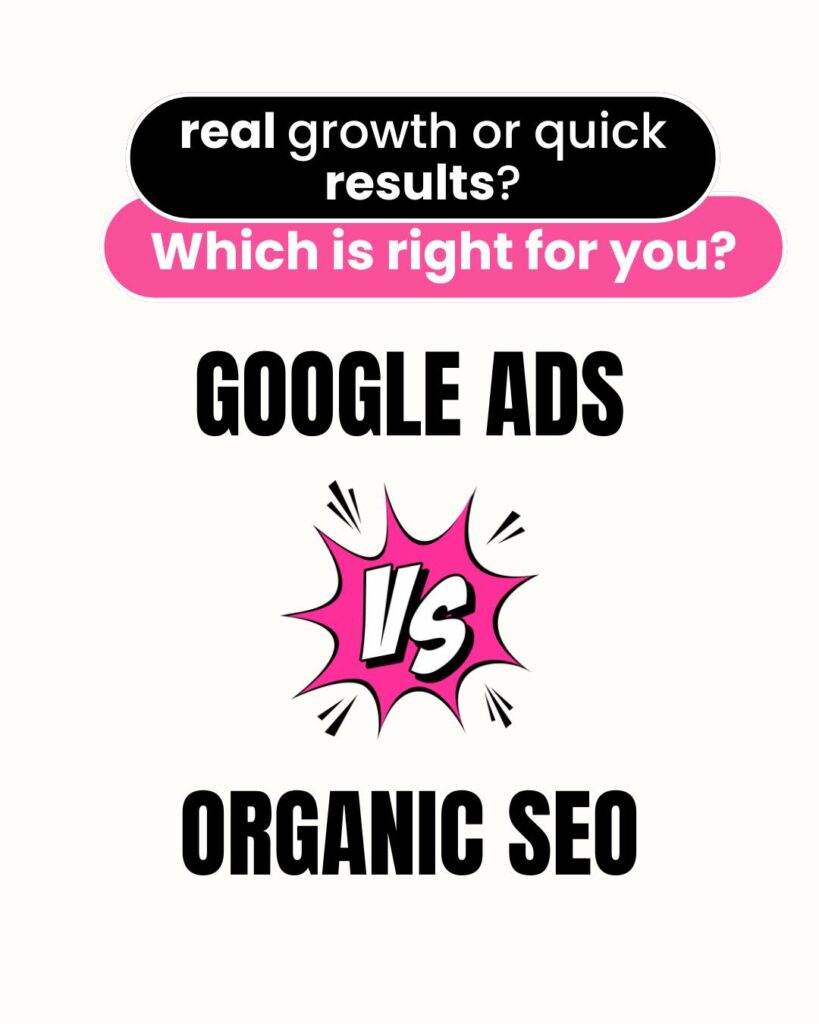When you run a small business, you need to reach people who want what you offer. Two major ways to do that are through Search Engine Optimization (SEO) and Google Ads. Both aim to get your business in front of potential customers when they search online, but they do so in very different ways.

This blog will cover what these methods are, how they work, what they can do for a small business, and how you might decide between them or use them together.
Understanding SEO: What It Is and How It Works
SEO stands for Search Engine Optimization. It’s the practice of making changes to your website so that search engines (like Google) understand it better and show it in search results when people type in relevant keywords or phrases.
Think of SEO as building a reputation with Google. The more you optimize your site, the more likely Google is to recommend it to people looking for information or services like yours.
SEO involves several steps:
- Keyword research: Finding the phrases people use to search for businesses like yours. The right keywords help Google understand what your site is about and which users should see it.
- On-page optimization: Making sure pages on your site have clear titles, meta descriptions, and headings that match what people are searching for. You also want to add helpful images and clear links.
- Content creation: Writing blog posts, guides, and product descriptions that answer common questions. Quality content brings visitors and keeps them reading.
- Technical optimization: Improving your site’s speed, mobile-friendliness, and overall structure so Google can easily crawl and index it. This includes using a secure connection (HTTPS) and making sure your pages load quickly.
- Building trust: Earning links from reputable websites and maintaining positive reviews to show that other people trust your business.
Why SEO Important for Small Businesses
SEO matters because people use search engines to find what they need. When your website shows up at the top of search results, more people will likely choose your business. SEO saves money in the long run too. While it takes time to set up and see results, you don't pay for each visitor to your site. Once your website ranks high, you get steady visitors without paying for each click.
Some major advantages of SEO for a small business include:
- Long-term benefits: SEO is like building a house foundation. Once your website ranks well on Google, you get free visitors and stay visible online. You might need small updates now and then, but your rankings usually stay strong.
- Trust and credibility: People trust regular search results more than ads. When your site appears naturally in searches, visitors tend to think you're offering real value, not just paying for attention.
- Better user experience: Making your website better for SEO means it becomes easier to use and loads faster. This helps visitors stay longer, read more, and reach out to you.
Challenges of SEO
Although SEO is powerful, it has drawbacks:
- Time-consuming: You can’t rush results. It may take months before your efforts pay off, which can feel frustrating if you need immediate traffic.
- Constant changes: Search engines update their rules and ranking criteria often. You must stay informed and adapt your strategy to keep your ranking.
- Competition: Many businesses want to rank for the same keywords. It takes effort and resources to stand out against them.
Diving into Google Ads: The Basics
Google Ads is a simple advertising system where you pay only when someone clicks your ad. Instead of waiting months for your website to show up naturally in search results, you pay Google to show your ad right away at the top or bottom of the page.

These ads look like regular search results but have an "Ad" label. You pick words related to your business, write your ad text, set how much money you want to spend, and choose how much you'll pay for each click.
Google Ads consist of several elements:
- Keyword bids: You tell Google which search terms you want to bid on. The more competitive the keyword, the higher the cost per click.
- Quality Score: Google scores your ad based on how relevant it is to the keyword and how well the ad’s landing page answers the searcher’s needs. Better quality ads cost less per click.
- Ad copy: You write headlines and descriptions that attract attention, explain your offer, and encourage people to click.
- Ad extensions: These add extra information to your ad, such as phone numbers, site links, or callouts like “Free Consultation.”
Why Google Ads Important for Small Businesses
Google Ads provide instant visibility. If you need to promote a new product or service or draw attention quickly, ads can get your site in front of customers almost immediately. Here are the main benefits of Google Ads:
- Speed: Your ads can go live within hours, giving your business immediate exposure. This is handy when you need quick results.
- Targeting: Ads allow you to focus on a specific location, age group, device type, or even when your ads appear during the day. For example, a local café might only show ads to people searching nearby during breakfast hours.
- Budget control: You control how much you spend every day and you can increase or decrease your budget whenever you want. Google Ads also let you set a limit on the maximum amount you’ll pay per click.
- Measurable results: You can track every click, see which keywords bring the most customers, and adjust your campaign accordingly. It’s easy to test different headlines or landing pages to see what works best.
Challenges of Google Ads
While Google Ads offer quick results, they also come with downsides:
- Costs add up: You pay each time someone clicks, regardless of whether they buy anything. If your ads aren’t well-targeted, you can spend a lot without seeing returns.
- Temporary results: Your visibility stops as soon as you pause or end your campaigns. There’s no lasting benefit after you stop paying.
- Complexity: Setting up campaigns, bidding on keywords, and writing compelling ads all require time and ongoing attention. If you aren’t careful, you might spend money on keywords that don’t convert.
Comparing SEO and Google Ads

Understanding the main differences between SEO and Google Ads will help you pick the right one for your business. Both can bring you customers, but they work differently.
Cost
- SEO: You pay for website improvements and content. Once your site ranks well, visitors are free. Costs stay fairly steady, but you'll need regular updates.
- Google Ads: You pay each time someone clicks your ad. Costs change based on the keywords you choose. For ongoing traffic, you need a consistent budget.
Speed
- SEO: Takes months to see results. The good part is once you rank well, you can stay there with less work.
- Google Ads: Your business shows up at the top of search results within hours. If you need visitors right away, ads are the fastest option.
Trust and Perception
- SEO: Natural search listings get more clicks because people trust them more.
- Google Ads: Some people skip ads completely. Others will click if they see something valuable offered.
Staying Power
- SEO: Good rankings can last for months or years. You get steady visitors without paying per click.
- Google Ads: When you stop paying, your ads disappear and your visitors stop coming.
Targeting and Flexibility
- SEO: You target topics through your content. You can change your approach over time, but changes aren't instant.
- Google Ads: You can start, change, or stop campaigns quickly. You can target specific locations, times, and audiences for better control.
Making the Choice: Which Strategy Suits Your Business?
So which one is better? The answer depends on your goals, timeline, and budget.
When to Choose SEO
- Long-Term Growth: If you want consistent traffic over time, SEO is the best choice. It builds a strong foundation that can support your business for years.
- Budget-Friendly: If you don’t have a large monthly advertising budget, SEO can be more cost-effective in the long run. Initial costs may be higher, but you save as organic traffic grows.
- Building Authority: Good SEO strengthens your brand. High rankings show that your business is credible and trustworthy.
When to Choose Google Ads
- Immediate Results: If you need to promote a sale or launch quickly, Google Ads is ideal. You’ll appear at the top of search results right away, giving your campaign instant visibility.
- Precise Targeting: Google Ads let you narrow your focus to a certain group of people or time of day. If you provide a local service, you can target local audiences effectively.
- Testing Keywords: Ads are excellent for testing which keywords convert before investing in SEO. Once you know what terms work, you can build more content around them.
Combining SEO and Google Ads
Many small businesses use both methods to maximize their reach. Here’s how you can do that:
- Start With Ads: Use Google Ads to jumpstart traffic and test which keywords bring in leads. This helps you understand your market quickly.
- Invest in SEO: Use what you learn from your ads to optimize your website content. Over time, strong SEO helps your site rank for those keywords naturally.
- Maintain Ads Strategically: Even after SEO picks up, keep some budget for ads during key seasons or promotions. Ads can help you maintain a presence while you continue to improve organic rankings.
Tips for Success With SEO and Google Ads
- Know Your Audience: Whether you choose SEO, Google Ads, or both, know who you want to reach. Understand their pain points, what questions they search, and what words they use.
- Optimize Your Website: A fast, mobile-friendly site improves both SEO and ad performance. If people click on an ad and find a slow or confusing page, they may leave immediately.
- Track Your Results: Use tools like Google Analytics and Google Ads data to monitor visitors, conversions, and customer behavior. Adjust your strategy based on these insights.
- Write Quality Content: Good content helps your SEO and makes your ads more effective. Useful information builds trust with readers and keeps them engaged.
- Adapt and Evolve: Digital marketing trends change. Algorithms update. New competitors appear. Stay up to date and be ready to adjust your approach.
You don't need to pick just one between SEO and Google Ads. Think about what you need most. Need visitors right away? Try Google Ads. Want people to find you naturally over time without paying per click? Go with SEO. Better yet, use both together. Start with ads to get quick traffic and find what works, then build your SEO around those successful keywords for lasting results.
No matter what you choose, be clear and consistent. Give people helpful information, answer their questions, and stick with your plan. Whether it's a blog post or an ad, putting your customers first will get you better results.